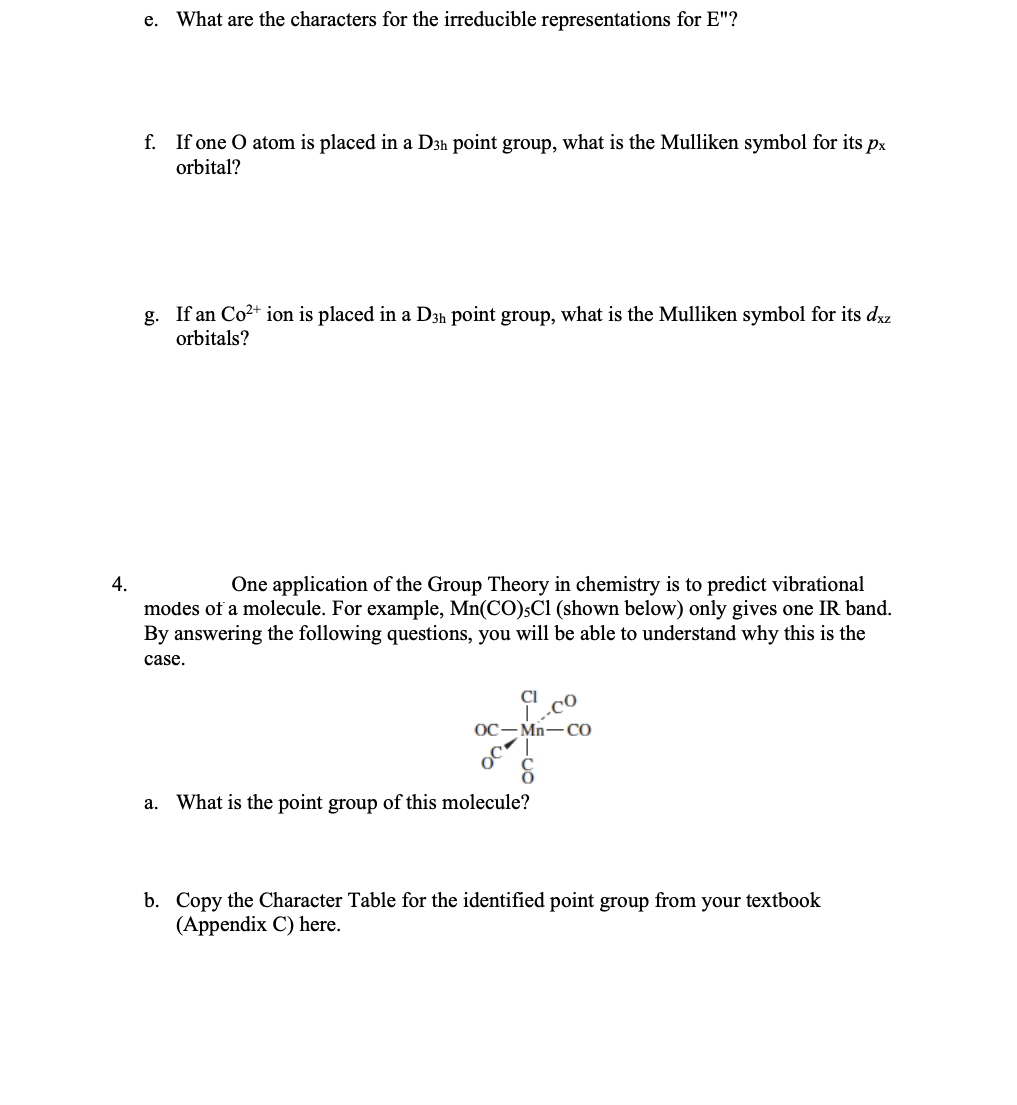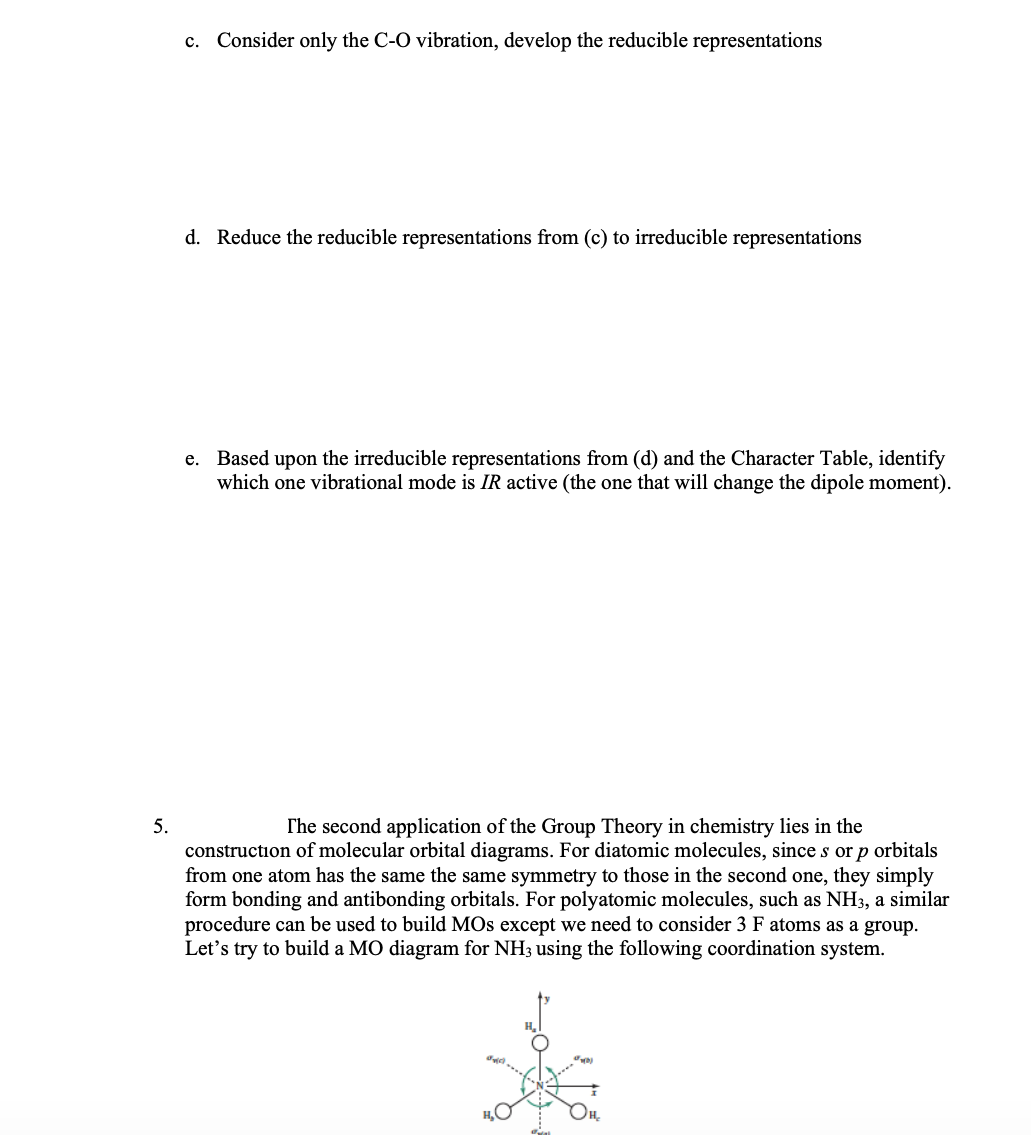4. One application of the Group Theory in chemistry is to predict vibrational modes of a molecule. For example, Mn(CO),Cl (shown below) only gives one IR band. By answering the following questions, you will be able to understand why this is the case. CL.co OC-Mn-CO a. What is the point group of this molecule? b. Copy the Character Table for the identified point group from your textbook (Appendix C) here.
4. One application of the Group Theory in chemistry is to predict vibrational modes of a molecule. For example, Mn(CO),Cl (shown below) only gives one IR band. By answering the following questions, you will be able to understand why this is the case. CL.co OC-Mn-CO a. What is the point group of this molecule? b. Copy the Character Table for the identified point group from your textbook (Appendix C) here.
Physical Chemistry
2nd Edition
ISBN:9781133958437
Author:Ball, David W. (david Warren), BAER, Tomas
Publisher:Ball, David W. (david Warren), BAER, Tomas
Chapter13: Introduction To Symmetry In Quantum Mechanics
Section: Chapter Questions
Problem 13.31E: Structural isomers can have very different point groups. There are three isomers of dichlorobenzene....
Related questions
Question

Transcribed Image Text:e. What are the characters for the irreducible representations for E"?
f. If one O atom is placed in a D3h point group, what is the Mulliken symbol for its px
orbital?
g. If an Co²+ ion is placed in a D3h point group, what is the Mulliken symbol for its dxz
orbitals?
4.
One application of the Group Theory in chemistry is to predict vibrational
modes of a molecule. For example, Mn(CO)5Cl (shown below) only gives one IR band.
By answering the following questions, you will be able to understand why this is the
case.
OC-Mn- СО
OC
a. What is the point group of this molecule?
b. Copy the Character Table for the identified point group from your textbook
(Appendix C) here.

Transcribed Image Text:c. Consider only the C-O vibration, develop the reducible representations
d. Reduce the reducible representations from (c) to irreducible representations
e. Based upon the irreducible representations from (d) and the Character Table, identify
which one vibrational mode is IR active (the one that will change the dipole moment).
5.
The second application of the Group Theory in chemistry lies in the
construction of molecular orbital diagrams. For diatomic molecules, since s or p orbitals
from one atom has the same the same symmetry to those the second one, they simply
form bonding and antibonding orbitals. For polyatomic molecules, such as NH3, a similar
procedure can be used to build MOs except we need to consider 3 F atoms as a group.
Let's try to build a MO diagram for NH3 using the following coordination system.
31(0)
Expert Solution
This question has been solved!
Explore an expertly crafted, step-by-step solution for a thorough understanding of key concepts.
Step by step
Solved in 4 steps with 3 images

Knowledge Booster
Learn more about
Need a deep-dive on the concept behind this application? Look no further. Learn more about this topic, chemistry and related others by exploring similar questions and additional content below.Recommended textbooks for you

Physical Chemistry
Chemistry
ISBN:
9781133958437
Author:
Ball, David W. (david Warren), BAER, Tomas
Publisher:
Wadsworth Cengage Learning,

Organic Chemistry: A Guided Inquiry
Chemistry
ISBN:
9780618974122
Author:
Andrei Straumanis
Publisher:
Cengage Learning


Physical Chemistry
Chemistry
ISBN:
9781133958437
Author:
Ball, David W. (david Warren), BAER, Tomas
Publisher:
Wadsworth Cengage Learning,

Organic Chemistry: A Guided Inquiry
Chemistry
ISBN:
9780618974122
Author:
Andrei Straumanis
Publisher:
Cengage Learning
